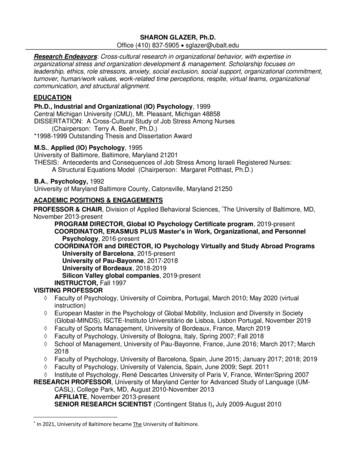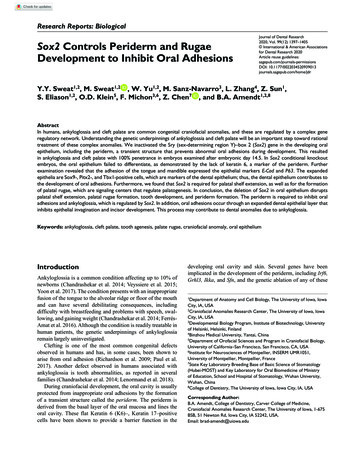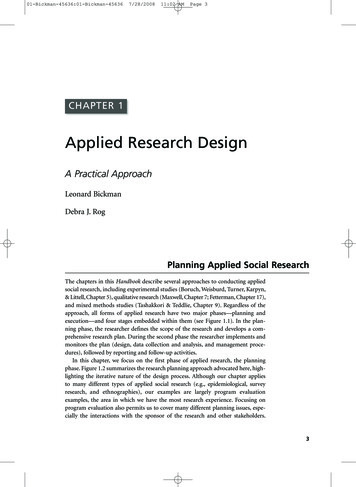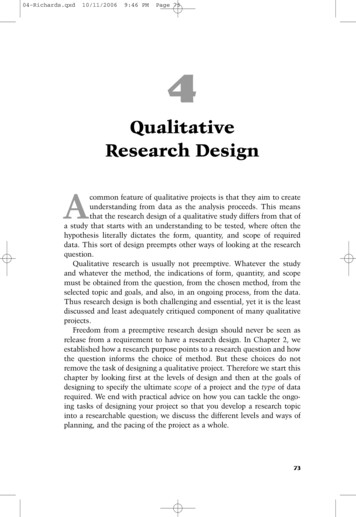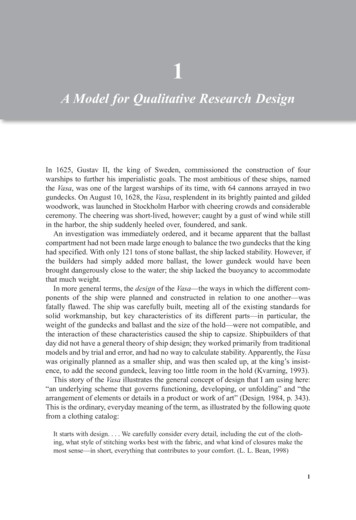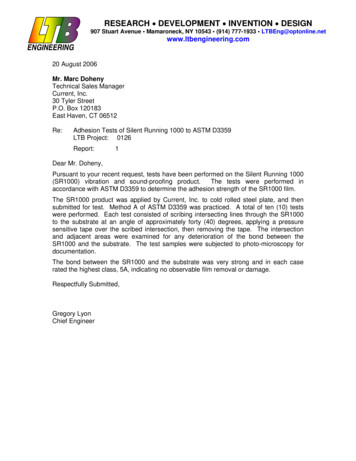
Transcription
RESEARCH DEVELOPMENT INVENTION DESIGN907 Stuart Avenue Mamaroneck, NY 10543 (914) 777-1933 ING20 August 2006Mr. Marc DohenyTechnical Sales ManagerCurrent, Inc.30 Tyler StreetP.O. Box 120183East Haven, CT 06512Re:Adhesion Tests of Silent Running 1000 to ASTM D3359LTB Project: 0126Report:1Dear Mr. Doheny,Pursuant to your recent request, tests have been performed on the Silent Running 1000(SR1000) vibration and sound-proofing product.The tests were performed inaccordance with ASTM D3359 to determine the adhesion strength of the SR1000 film.The SR1000 product was applied by Current, Inc. to cold rolled steel plate, and thensubmitted for test. Method A of ASTM D3359 was practiced. A total of ten (10) testswere performed. Each test consisted of scribing intersecting lines through the SR1000to the substrate at an angle of approximately forty (40) degrees, applying a pressuresensitive tape over the scribed intersection, then removing the tape. The intersectionand adjacent areas were examined for any deterioration of the bond between theSR1000 and the substrate. The test samples were subjected to photo-microscopy fordocumentation.The bond between the SR1000 and the substrate was very strong and in each caserated the highest class, 5A, indicating no observable film removal or damage.Respectfully Submitted,Gregory LyonChief Engineer
Mr. Marc DohenyDisplay TechnologiesLTB Report 0126-1Page 2 of 8Objective:This report will document the tests and results in accordance with ASTM D3359 of theadhesion of Silent Running 1000 (SR1000) noise and vibration dampening material.Materials Tested:Materials tested consisted of the SR1000 material applied to a cold rolled steel platemeasuring 11 inches square and 0.15 inch thick. The plate surface was cleaned withacetone and lightly abraded with 80# sand paper in a crosshatch pattern. Afterwards,the surface was again cleaned with acetone, allowed to dry, and wiped with a clean dryrag. The SR1000 was sprayed onto the surface using a Binks 2001 spray gun andpressure pot. A second coat was applied once the first was dry to the touch afterapproximately 1 hour for a final average thickness of 0.038 inch. The material wasallowed to cure for 5 days after application before testing.Test Methods:Tests were conducted in accordance with ASTM D3359, Test Method A. All tests wereperformed at conditions of 73 F and 60% RH.The test materials prepared as described above were mapped with a pencil so as toallow relatively accurate scribing. Scribing consisted of cutting through the film with anew scalpel blade with considerable pressure.The scribe was examinedmicroscopically to ensure penetration. Scribe marks were prepared in the form of an X,the smaller angle at approximately 40 .Permacel P99 pressure sensitive adhesive packing tape was utilized for the testing froma one inch wide roll. The adhesive to adhesive strength of the tape was measured at apull rate of approximately 1 inch per second and indicated a maximum reading of 7.62lbf. The failure mode was a combination of adhesive and cohesive separation. Twocomplete layers of tape were removed before applying an approximately three inchlength centrally over each of the scribed X’s. A pencil eraser was rubbed across thetape surface over the X to improve wetted area.After approximately 90 seconds, the tape was removed quickly at an angle of 180 . Thescribed X was examined for any signs of separation or damage and the observationswere recorded. Each X was documented via photomicroscopy.The tests were conducted twice on set up locations, then ten times on random locationsof the plate.Test Results:All of the scribed X’s had no observable damage; using the criteria of ASTM D 3359,each test scored a 5A result; the best possible. The photomicrographs of each test arepresented in figures one through 10. In each case a blue tape of 0.125 inch in width ispresented for calibration.
Mr. Marc DohenyDisplay TechnologiesLTB Report 0126-1Page 3 of 8Figure 1: Test number 1 results0.125Figure 2: Test number 2 results
Mr. Marc DohenyDisplay TechnologiesLTB Report 0126-1Page 4 of 8Figure 3: Test number 3 resultsFigure 4: Test number 4 results
Mr. Marc DohenyDisplay TechnologiesLTB Report 0126-1Page 5 of 8Figure 5: Test number 5 resultsFigure 6: Test number 6 results
Mr. Marc DohenyDisplay TechnologiesLTB Report 0126-1Page 6 of 8Figure 7: Test number 7 resultsFigure 8: Test number 8 results
Mr. Marc DohenyDisplay TechnologiesLTB Report 0126-1Page 7 of 8Figure 9: Test number 9 resultsFigure 10: Test number 10 results
Mr. Marc DohenyDisplay TechnologiesLTB Report 0126-1Page 8 of 8Conclusions:Tests have been performed on Silent Running 1000 (SR1000) vibration and soundproofing product. The tests were performed in accordance with ASTM D3359 todetermine the bond strength of the SR1000 film.The SR1000 product was applied by Current, Inc. to cold rolled steel plate, and thensubmitted for test. Method A of ASTM D3359 was practiced. A total of ten (10) testswere performed. Each test consisted of scribing intersecting lines through the SR1000to the substrate at an angle of approximately forty (40) degrees, applying a pressuresensitive tape over the scribed intersection, then removing the tape. The intersectionand adjacent areas were examined for any deterioration of the bond between theSR1000 and the substrate. The test samples were subjected to photo-microscopy fordocumentation.The bond between the SR1000 and the substrate was very strong and in each caserated the highest class, 5A indicating no observable film removal or damage.
The tests were performed in accordance with ASTM D3359 to determine the bond strength of the SR1000 film. The SR1000 product was applied by Current, Inc. to cold rolled steel plate, and then submitted for test. Method A of ASTM D3359 was practiced. A total of ten (10) tests were performed. Each test consisted of scribing intersecting lines through the SR1000 to the substrate at an angle of .

